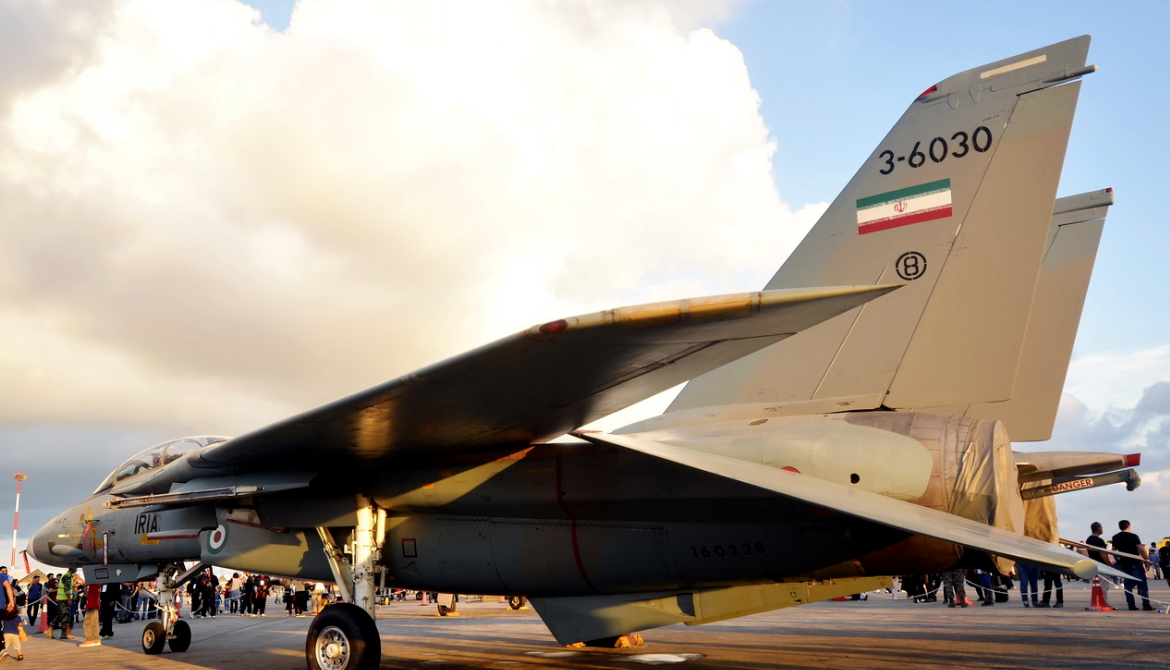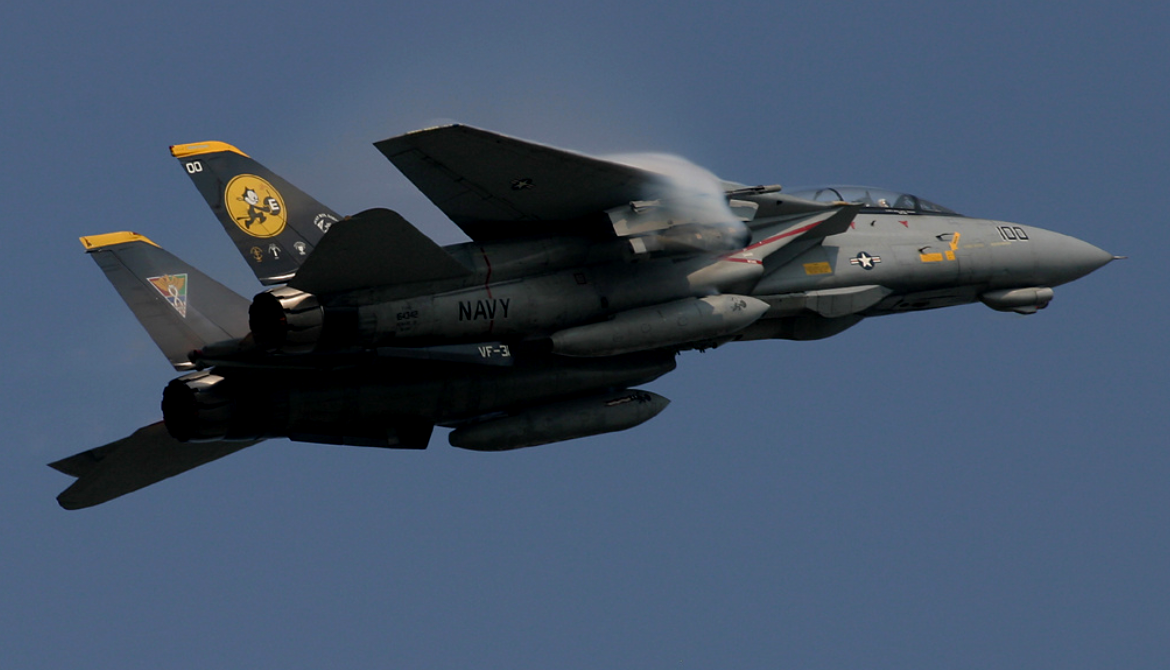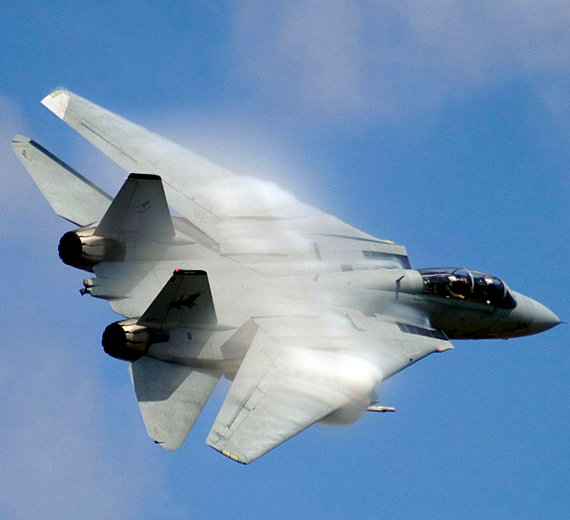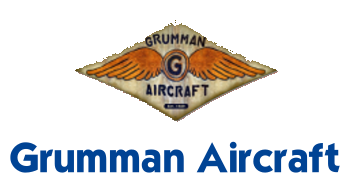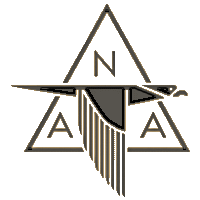Grumman Aerospace Grumman F-14 Tomcat
Role Interceptor, air superiority, and multirole fighter
National origin United States
Manufacturer Grumman
First flight 21 December 1970
Introduction 22 September 1974
Retired 22 September 2006 (United States Navy)
Status In service with the Islamic Republic of Iran Air Force
Primary users United States Navy
Produced 1969–1991
Number built 712
.
History Grumm![]() an Aerospace
an Aerospace
Grumman F-14 Tomcat
The F-14 first flew on 21 December 1970 and made its first deployment in 1974 with the U.S. Navy aboard USS Enterprise (CVN-65), replacing the McDonnell Douglas F-4 Phantom II. The F-14 served as the U.S. Navy's primary maritime air superiority fighter, fleet defense interceptor, and tactical aerial reconnaissance platform into the 2000s. The Low Altitude Navigation and Targeting Infrared for Night (LANTIRN) pod system was added in the 1990s and the Tomcat began performing precision ground-attack missions
The F-14's fuselage and wings allow it to climb faster than the F-4, while the "twin-tail" empennage (dual vertical stabilizers with ventral fins on the engine nacelles) offers better stability. The F-14 is equipped with an internal 20 mm M61 Vulcan rotary cannon mounted on the left side (unlike the Phantom, which was not equipped with an internal gun in the US Navy), and can carry AIM-54 Phoenix, AIM-7 Sparrow, and AIM-9 Sidewinder anti-aircraft missiles. The twin engines are housed in widely spaced nacelles. The flat area of the fuselage between the nacelles is used to contain fuel and avionics systems, such as the wing-sweep mechanism and flight controls, as well as weaponry since the wings are not used for carrying ordnance. By itself, the fuselage provides approximately 40 to 60 percent of the F-14's aerodynamic lifting surface depending on the wing sweep position.The lifting body characteristics of the fuselage allowed one F-14 to safely land after suffering a mid-air collision that sheared off more than half of the plane's right wing in 19910
KmTake off Distance
0
mRange
0
MachAircraft Speed
0
Max Crew
Photo Gallery
Grumman F-14 Tomcat


Grumman Aerospace Corporation
Grumman F-14 Tomcat
General characteristics
- Crew: 2 (pilot and radar intercept officer)
- Length: 62 ft 9 in (19.13 m)
- Wingspan: (19.545 m)
- Swept wingspan: (11.646 m) swept
- Height: 16 ft (4.9 m)
-
Wing area:52.5 m2) wings only
- 1,008 sq ft (94 m2) effective area including fuselage
Powerplant
- Empty weight: (19,838 kg)
- Gross weight:(27,669 kg)
- Max takeoff weight: (33,725 kg)
- Fuel capacity: (7,348 kg) internal fuel; 2 × optional 267 US gal (222 imp gal; 1,010 L) / 1,756 lb (797 kg) external tanks
- Powerplant: 2 × General Electric F110-GE-400 afterburning turbofans, 16,333 lbf (72.65 kN) thrust each dry, 26,950 lbf (119.9 kN) with afterburne
Specifications
- Maximum speed: Mach 2.34 (1,544 mph, 2,485 km/h) at altitude
- Range: 1,600 nmi (1,800 mi, 3,000 km)
- Combat range: (580 mi, 930 km)
- Service ceiling: (16,000 m) plus
- g limits: +7.5 g (+6.5 g limit)
- Rate of climb: 45,000 ft/min (230 m/s) plus
Armament
-
- Guns: 1× 20 mm (0.787 in) M61A1 Vulcan 6-barreled rotary cannon, with 675 rounds
-
Hardpoints: 10 total: 6× under-fuselage, 2× under nacelles and 2× on wing gloves with a capacity of (6,600 kg) of ordnance and fuel tanks.
- Rockets: 7x LAU-10 rocket pods (for a total of 28 rockets)
- Missiles: AIM-54 Phoenix, AIM-7 Sparrow, AIM-9 Sidewinder air-to-air missiles
-
Links to Youtube & Others
The Grumman Aircraft Engineering Corporation, later Grumman Aerospace Corporation, was a 20th century American producer of military and civilian aircraft. Founded on December 6, 1929, by Leroy Grumman and his business partners, it merged in 1994 with Northrop Corporation to form Northrop Grumman.
Grumman F-14 Tomcat
The F-14 Tomcat was designed as both an air superiority fighter and a long-range naval interceptor.
Youtube Link
At the time of filming, the only recognizable star in the movie was Tom Cruise, who was known as a teen idol from 1983’s “Risky Business.”.




